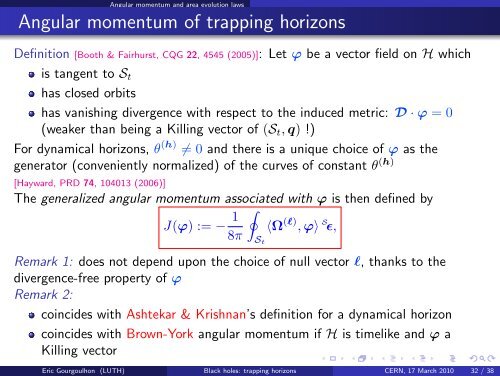Black holes: from event horizons to trapping horizons - LUTH ...
Black holes: from event horizons to trapping horizons - LUTH ...
Black holes: from event horizons to trapping horizons - LUTH ...
Create successful ePaper yourself
Turn your PDF publications into a flip-book with our unique Google optimized e-Paper software.
Angular momentum and area evolution laws<br />
Angular momentum of <strong>trapping</strong> <strong>horizons</strong><br />
Definition [Booth & Fairhurst, CQG 22, 4545 (2005)]: Let ϕ be a vec<strong>to</strong>r field on H which<br />
is tangent <strong>to</strong> St<br />
has closed orbits<br />
has vanishing divergence with respect <strong>to</strong> the induced metric: D · ϕ = 0<br />
(weaker than being a Killing vec<strong>to</strong>r of (St, q) !)<br />
For dynamical <strong>horizons</strong>, θ (h) = 0 and there is a unique choice of ϕ as the<br />
genera<strong>to</strong>r (conveniently normalized) of the curves of constant θ (h)<br />
[Hayward, PRD 74, 104013 (2006)]<br />
The generalized angular momentum associated with ϕ is then defined by<br />
J(ϕ) := − 1<br />
<br />
〈Ω<br />
8π<br />
(ℓ) , ϕ〉 S ɛ,<br />
Remark 1: does not depend upon the choice of null vec<strong>to</strong>r ℓ, thanks <strong>to</strong> the<br />
divergence-free property of ϕ<br />
Remark 2:<br />
coincides with Ashtekar & Krishnan’s definition for a dynamical horizon<br />
coincides with Brown-York angular momentum if H is timelike and ϕ a<br />
Killing vec<strong>to</strong>r<br />
St<br />
Eric Gourgoulhon (<strong>LUTH</strong>) <strong>Black</strong> <strong>holes</strong>: <strong>trapping</strong> <strong>horizons</strong> CERN, 17 March 2010 32 / 38
















